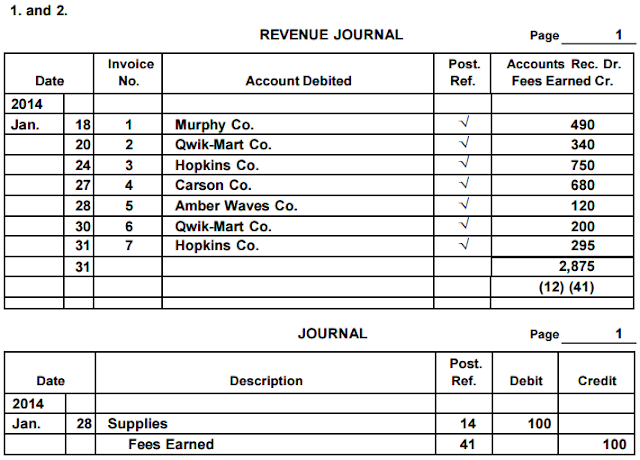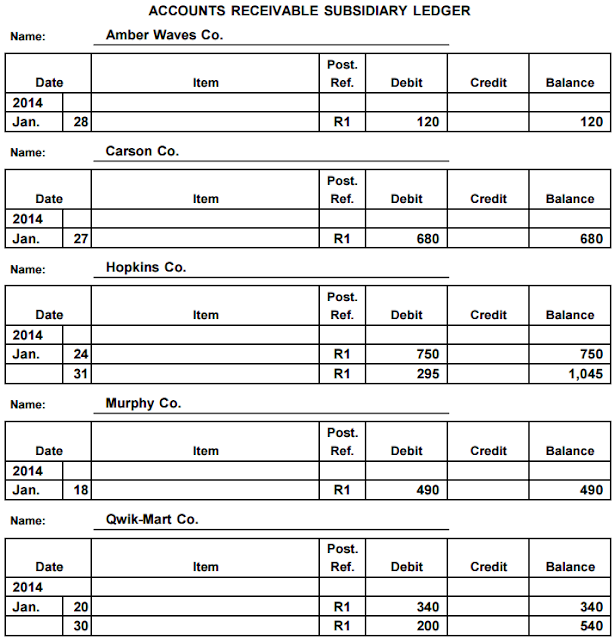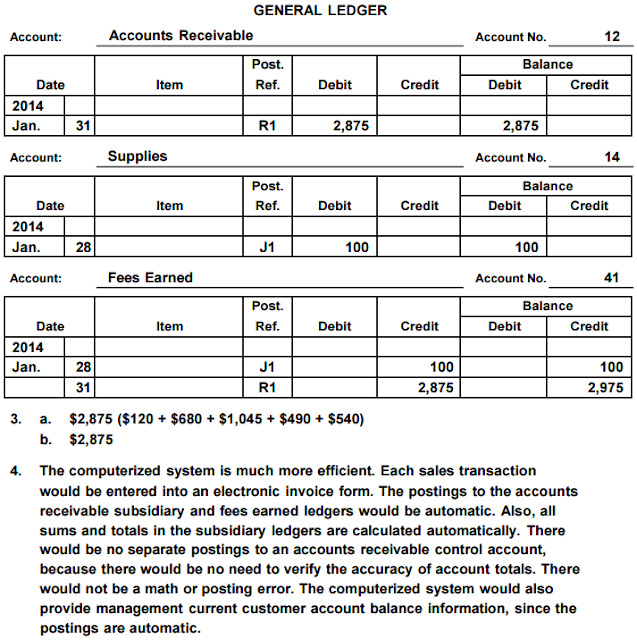Jan. 18. Issued Invoice No. 1 to Murphy Co. for $490 on account.
20. Issued Invoice No. 2 to Qwik-Mart Co. for $340 on account.
24. Issued Invoice No. 3 to Hopkins Co. for $750 on account.
27. Issued Invoice No. 4 to Carson Co. for $680 on account.
28. Issued Invoice No. 5 to Amber Waves Co. for $120 on account.
28. Provided security services, $100, to Qwik-Mart Co. in exchange for supplies.
30. Issued Invoice No. 6 to Qwik-Mart Co. for $200 on account.
31. Issued Invoice No. 7 to Hopkins Co. for $295 on account.
Instructions
1. Journalize the transactions for January, using a single-column revenue journal and a two-column general journal. Post to the following customer accounts in the accounts receivable ledger, and insert the balance immediately after recording each entry: Amber Waves Co.; Carson Co.; Hopkins Co.; Murphy Co.; Qwik-Mart Co.
2. Post the revenue journal to the following accounts in the general ledger, inserting the account balances only after the last postings:
12 Accounts Receivable
14 Supplies
41 Fees Earned
3.
a. What is the sum of the balances of the customer accounts in the subsidiary ledger at January 31?
b. What is the balance of the accounts receivable controlling account at January 31?
4. Assume Guardian Security Services began using a computerized accounting system to record the sales transactions on February 1. What are some of the benefits of the computerized system over the manual system?
Answer:



1. and 2.
REVENUE JOURNAL Page 1
Date
Invoice
No. Account Debited
Post.
Ref.
Accounts Rec. Dr.
Fees Earned Cr.
2014
Jan. 18 1 Murphy Co. √ 490
20 2 Qwik-Mart Co. √ 340
24 3 Hopkins Co. √ 750
27 4 Carson Co. √ 680
28 5 Amber Waves Co. √ 120
30 6 Qwik-Mart Co. √ 200
31 7 Hopkins Co. √ 295
31 2,875
(12) (41)
JOURNAL Page 1
Date Description
Post.
Ref. Debit Credit
2014
Jan. 28 Supplies 14 100
Fees Earned 41 100
ACCOUNTS RECEIVABLE SUBSIDIARY LEDGER
Name: Amber Waves Co.
Date Item
Post.
Ref. Debit Credit Balance
2014
Jan. 28 R1 120 120
Name: Carson Co.
Date Item
Post.
Ref. Debit Credit Balance
2014
Jan. 27 R1 680 680
Name: Hopkins Co.
Date Item
Post.
Ref. Debit Credit Balance
2014
Jan. 24 R1 750 750
31 R1 295 1,045
Name: Murphy Co.
Date Item
Post.
Ref. Debit Credit Balance
2014
Jan. 18 R1 490 490
Name: Qwik-Mart Co.
Date Item
Post.
Ref. Debit Credit Balance
2014
Jan. 20 R1 340 340
30 R1 200 540
GENERAL LEDGER
Account: Accounts Receivable Account No. 12
Date Item
Post.
Ref. Debit Credit
Balance
Debit Credit
2014
Jan. 31 R1 2,875 2,875
Account: Supplies Account No. 14
Date Item
Post.
Ref. Debit Credit
Balance
Debit Credit
2014
Jan. 28 J1 100 100
Account: Fees Earned Account No. 41
Date Item
Post.
Ref. Debit Credit
Balance
Debit Credit
2014
Jan. 28 J1 100 100
31 R1 2,875 2,975
3. a. $2,875 ($120 + $680 + $1,045 + $490 + $540)
b. $2,875
4. The computerized system is much more efficient. Each sales transaction
would be entered into an electronic invoice form. The postings to the accounts
receivable subsidiary and fees earned ledgers would be automatic. Also, all
sums and totals in the subsidiary ledgers are calculated automatically. There
would be no separate postings to an accounts receivable control account,
because there would be no need to verify the accuracy of account totals. There
would not be a math or posting error. The computerized system would also
provide management current customer account balance information, since the
postings are automatic.